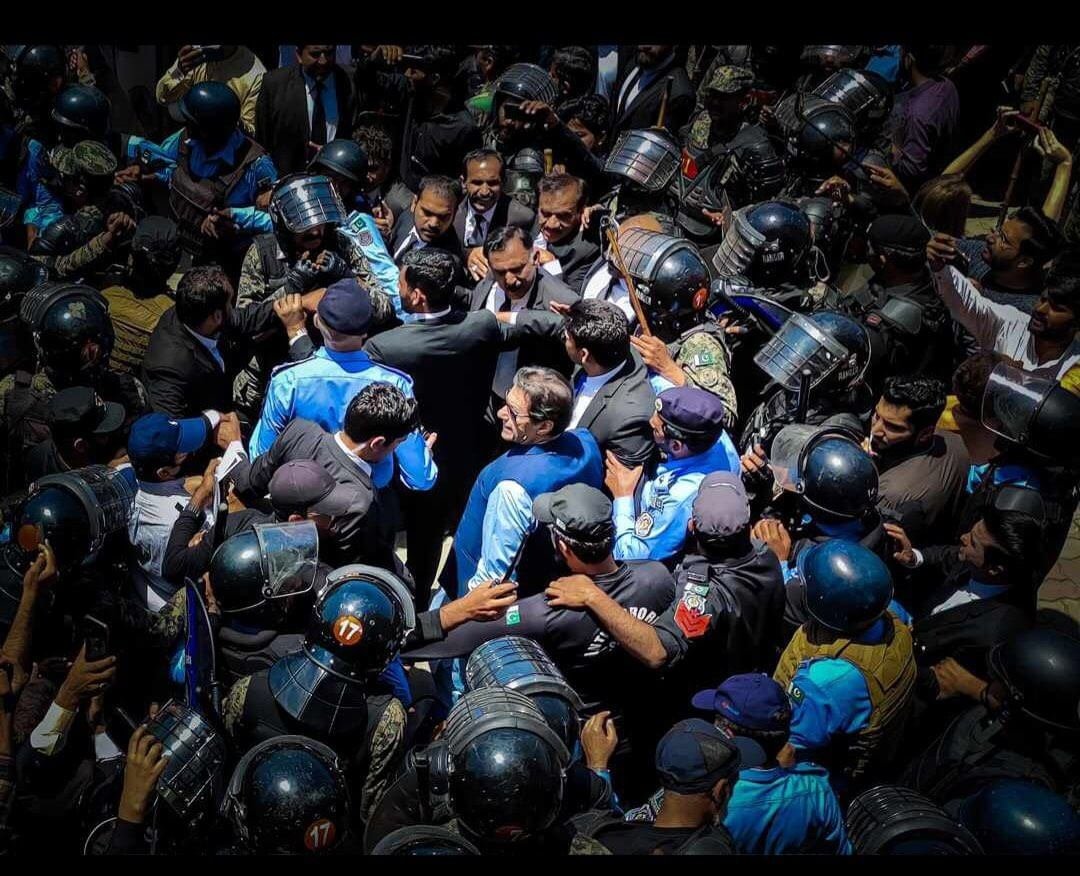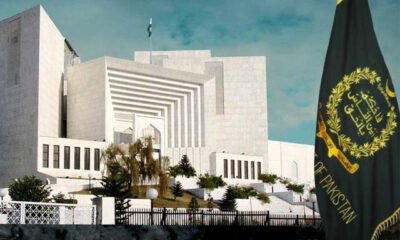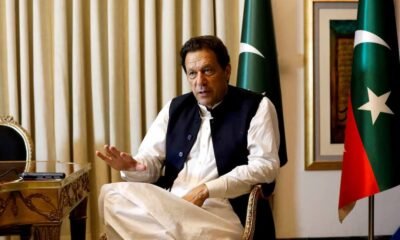Pakistan
May 9 False Flag Operation: A year on…
It’s been a year since the May 9 false flag operation—a year that was characterized by human rights violations & absence of law.

It has been a year since May 9, 2023, a day that will indeed go down as one of the most significant days in Pakistan’s history, regardless of what angle you look at it from.
It all started with Imran Khan’s visit to the Islamabad High Court for bail hearings in multiple cases. Before his departure from Lahore, Imran Khan addressed the rumours of his potential arrest in a video message from his car. He urged the authorities to present a warrant if they intended to arrest him, expressing his willingness to comply. However, he warned against any attempts of arbitrary arrest, citing potential public agitation and reactions given the political climate.
Paying no heed to the message, the authorities proceeded with the worst possible decision. As Khan was in the court premises, dozens of paramilitary troops in riot-control gear stormed the Islamabad High Court, smashing the windows of the court and tearing down the door. They physically attacked Imran Khan and his legal team, forcibly dragging the wounded Khan into a van. If it wasn’t abundantly evident by now, this abduction removed the façade of the military’s neutrality, particularly in the manner of Khan’s abduction from the court.
This act, aside from being illegal, was profoundly disturbing. Imran Khan holds a significant place in the hearts of the nation, and news of his violent arrest triggered an immediate and strong public outcry. PTI workers and supporters rallied across the country, demanding Khan’s immediate release. PTI leadership announced nationwide peaceful protests.
Amidst the chaos, reports emerged of attacks on government buildings and military installations by protesters. The government was quick to point fingers at PTI and Imran Khan, who in fact, was in illegal custody. The complete media blackout and internet shutdown obscured the true nature of events at the time. However, videos surfaced later that showed individuals in plainclothes being deployed to peaceful protest locations to instigate violence, revealing the orchestrated plan that was put in place to blame PTI for vandalism and use it as a pretext to launch a crackdown on the party’s leaders, workers, and supporters.
The events of May 9 were initially portrayed as acts of vandalism and arson against state institutions. However, extensive evidence, including videos and eyewitness testimonies, exposed the orchestrated nature of May 9 as a false flag operation to dismantle PTI.
The architects of this operation used this as an excuse to unleash a violent crackdown on PTI. Many PTI leaders were illegally arrested, detained, and pressured to give false testimony against PTI Chairman Imran Khan. They were also compelled to publicly denounce PTI and condemn the events of May 9 through scripted press conferences.
PTI leaders faced a choice: either quit PTI and be free or face arrest on fabricated charges. Despite court orders for their release, PTI leaders were re-arrested between six to eight times, or more, as they remained steadfast in their support for Imran Khan and the party. The courts appeared powerless to enforce their rulings, suggesting influence from sources beyond their jurisdiction.
What is rarely discussed in the media and the state narrative around May 9 are the 25 people who lost their lives as a result of firing by military personnel. In contrast, not a single police or military officer was injured.
And yet, the pretext of arson was used by the state of Pakistan to unleash a wave of terror, that has plunged Pakistan into tyranny. Pakistan post 9 May is marked by:
1. Blatant human rights violations
2. Lawlessness and a mockery of the law
3. Disregard of the constitution with impunity
Blatant human rights violations post 9 May
Following the 9 May false-flag operation, more than 10,000 PTI workers and supporters were arbitrarily detained in Punjab alone. A year on, some are still languishing in jail, and have been denied their basic & constitutional rights.
Illegal raids at homes in the dead of the night, threats, abductions, violence, vandalism and looting of houses became a norm. Across the country, and most commonly in Punjab, police would raid and plunder houses, detain citizens and demand ransom, all with complete impunity.
Furthermore, over 100 individuals have been in military custody, being tried in military courts, in complete violation of their constitutional rights.
Lawlessness and a mockery of the law post-9 May
Following the arbitrary arrests, a disturbing trend emerged: forced divorces, a phenomenon previously unheard of in politics. PTI leaders who were arrested by the authorities and subsequently given bail by the courts, found themselves repeatedly rearrested until they either renounced their support for PTI, withdrew from politics altogether, or joined the establishment’s party known as Istehkam-e-Pakistan Party (IPP).
Dozens of PTI leaders would appear on television, and condemn May 9, and their cases were magically dropped, and they were free. Others saw rearrests, as the state made a complete mockery of the law.
The judicial system, instead of providing relief, has been complicit in prolonging detention through bogus charges and re-arrests.
For instance, Sanam Javed, a PTI supporter, faces charges of inciting unrest in six locations across Lahore, Mianwali, and Faisalabad simultaneously. Similarly, PTI leader Aliya Hamza has been behind bars for over a year, accused of instigating chaos in five different locations spanning Lahore, Raiwind, and Mianwali, all at the same time.
Abrogation of the Constitution post 9 May
During this turbulence, the Supreme Court’s orders to conduct elections in Punjab and KP, as mandated by the Constitution of Pakistan, were blatantly disregarded. These elections were delayed until February 2024, during which the people’s mandate was shamelessly stolen.
The response to the 9 May false flag operation: The politics of resistance
May 9 was used as a pretext to justify unspeakable atrocities against a political party, with the sole purpose of dismantling PTI. The Pakistani establishment committed horrendous crimes against its people, sparing no one, not even children, women, or daughters. It used all available resources to inflict maximum humiliation and pain, both physically and psychologically, on its victims.
It targeted judges, journalists, academics, activists, lawyers, politicians, and workers. It threatened and intimidated all those who stood with the victims of state brutality, and showed its utterly despicable, brutal, and vile face.
In response to the sheer use of force, PTI adopted the politics of resistance. While several succumbed to pressure and threats, the party strengthened and became an inevitable force. The passive resistance and unwavering courage shown by its many leaders and supporters, particularly women including Dr. Yasmin Rashid, Aliya Hamza, Sanam Javed, Ayesha Bhutta and several others, turned them into faces of resistance.
Ultimately, PTI’s politics of resistance culminated with the people’s verdict in the February 8, 2024 elections, where people came out in huge numbers to bury the state narrative regarding May 9.
Clearly, the establishment underestimated the resilience of the people and their ability to see through propaganda and false narratives.
Today on 9 May, a year on, the people persevered and prevailed, and all those who stood against them have lost.
9 questions on 9 May
Despite the fact that the state narrative with regards to May 9 has been buried by the people, some questions still need to be asked.
Question 1: Who ordered the paramilitary troops to storm the Islamabad High Court. When Imran Khan had already expressed his willingness to comply with the courts, why was Ihe violently abducted, and who authorized this action?
Question 2: Where was the Punjab police during these events?
Question 3: Where was the Cantt’s military force during these events?
Question 4: Why was the security force at the core commander’s house moved away? If there was an alleged “attack” on the core commander’s house, why did the security personnel disappear?
Question 5: How was the gate of the core commander’s house opened so quickly, allowing instigators to enter?
Question 6: Where was the Garrison’s Quick Response Force during these events? Why didn’t military intelligence agencies respond to the alleged “onslaught on military installations”?
Question 7: Where is the CCTV footage of the core commander’s house?
Question 8: Why was core commander Lahore removed from his position?
Question 9: Why hasn’t there been a judicial inquiry into this incident?






